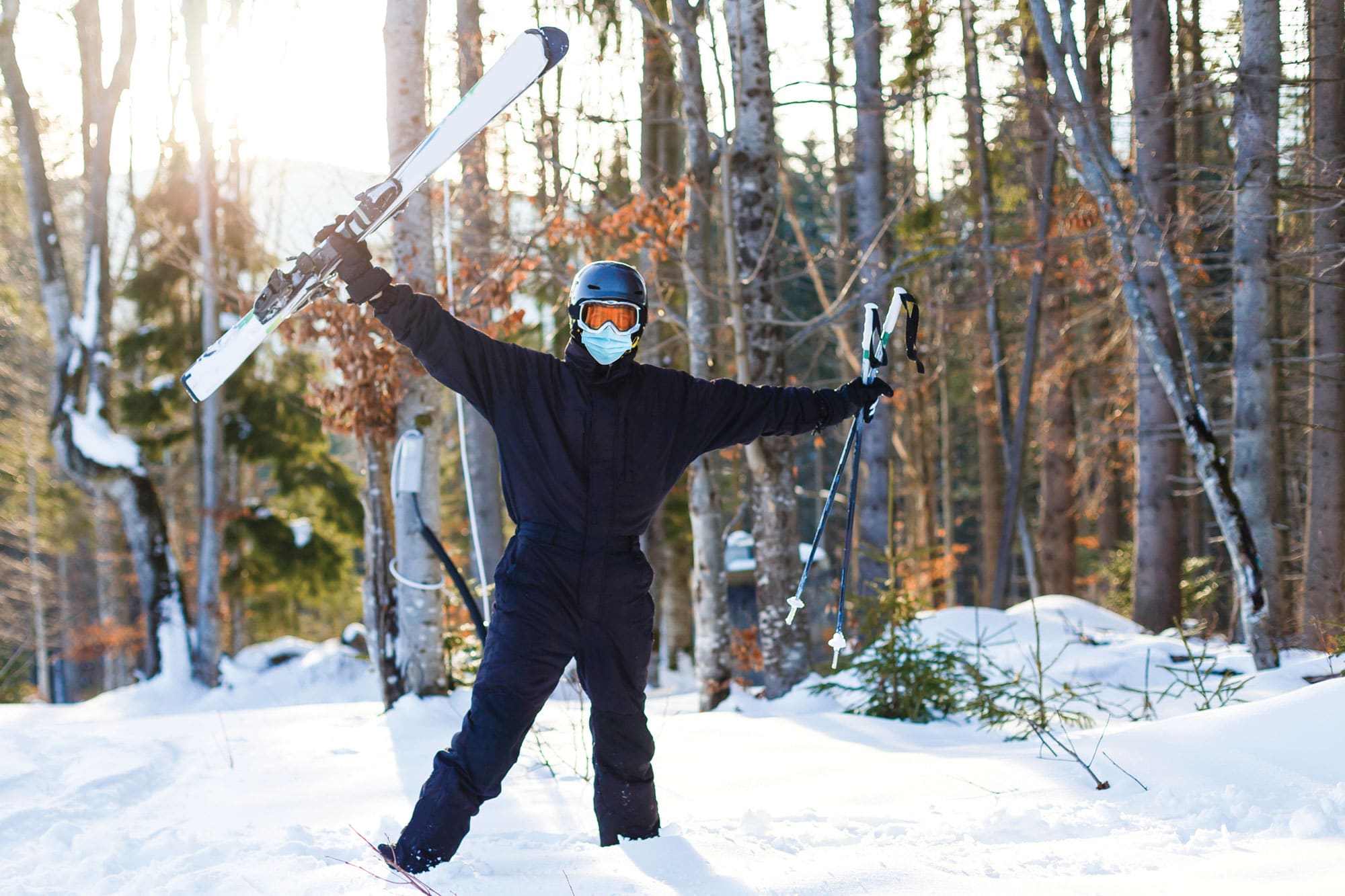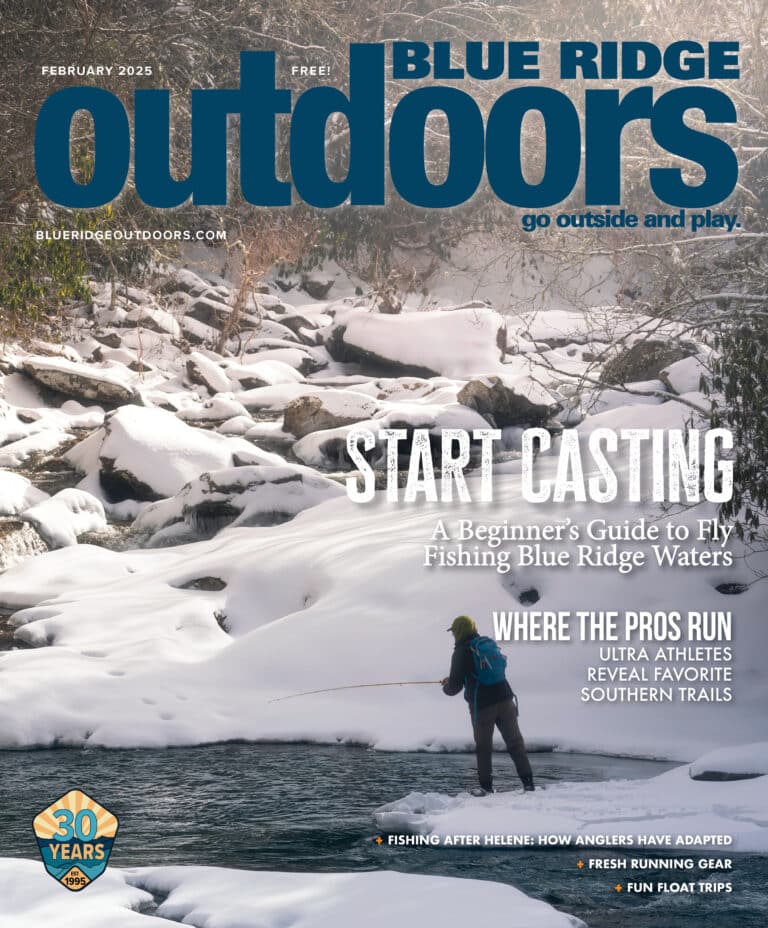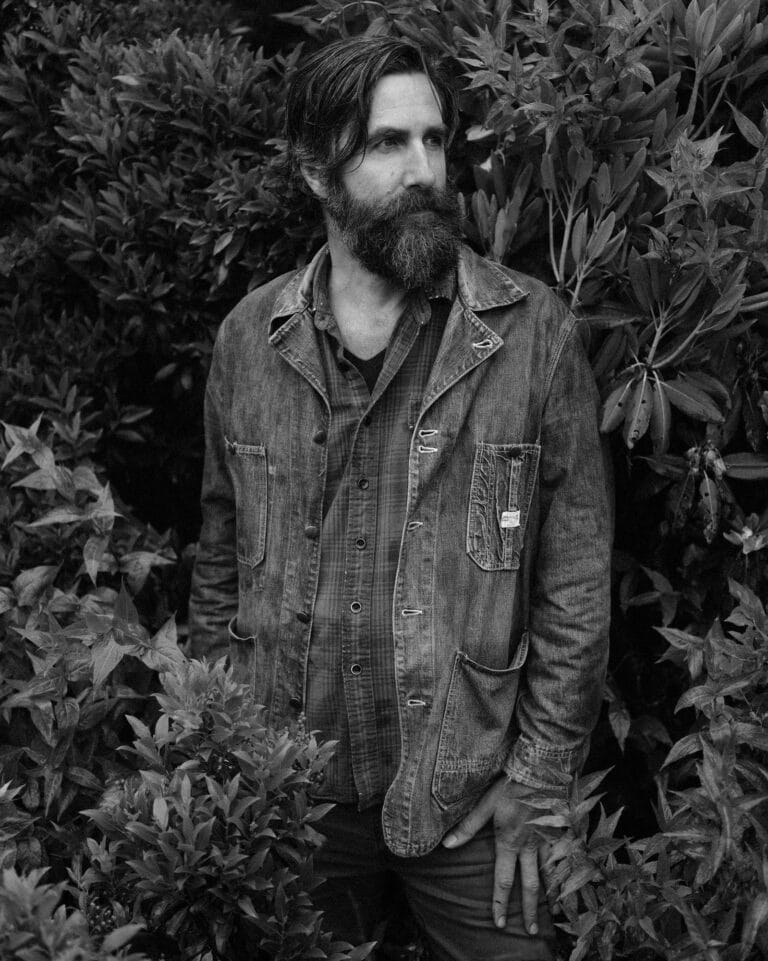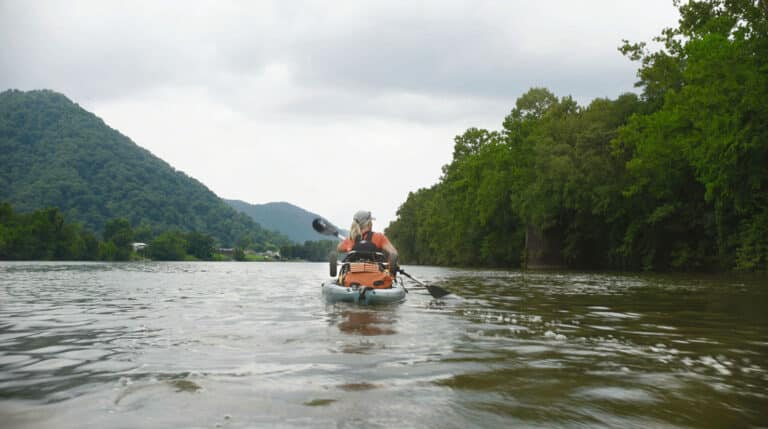Hitting the local slopes during the pandemic offers relatively low-risk winter fun—but it’s a little weird.
Snaking through the switchbacks of U.S. 250 into Virginia’s Highland County and the snow-strewn Allegheny Mountains of West Virginia brings an unfamiliar apprehension. My kids and I are headed to Snowshoe Mountain Resort for the opening day of ski season. In years past, the sight of powder-dusted trees and pastures evoked giddy anticipation—but the uncertainties of hitting the slopes during the pandemic undercut our festive spirit.
“We’ve been working overtime to get information out there so visitors know what to expect and feel confident they’ll be safe,” says Morgan Mowbray, marketing manager for Massanutten Resort in Virginia.
But issues like last-minute executive orders from the commonwealth’s Governor Ralph Northam around capacity limits for slopes and restaurants, surging U.S. infection rates, restrictions on exchange-student workers, and other problems have required ongoing adaptation.
Though virtually all U.S. resorts have core safety protocols in place, “this is so unprecedented, and there are so many variables, nobody’s operating at anything close to ideal efficiency right now,” says Kenny Hess, Massanutten’s director of sports. Ski area administrators have chosen “to err on the side of safety and make adjustments as we go along.”
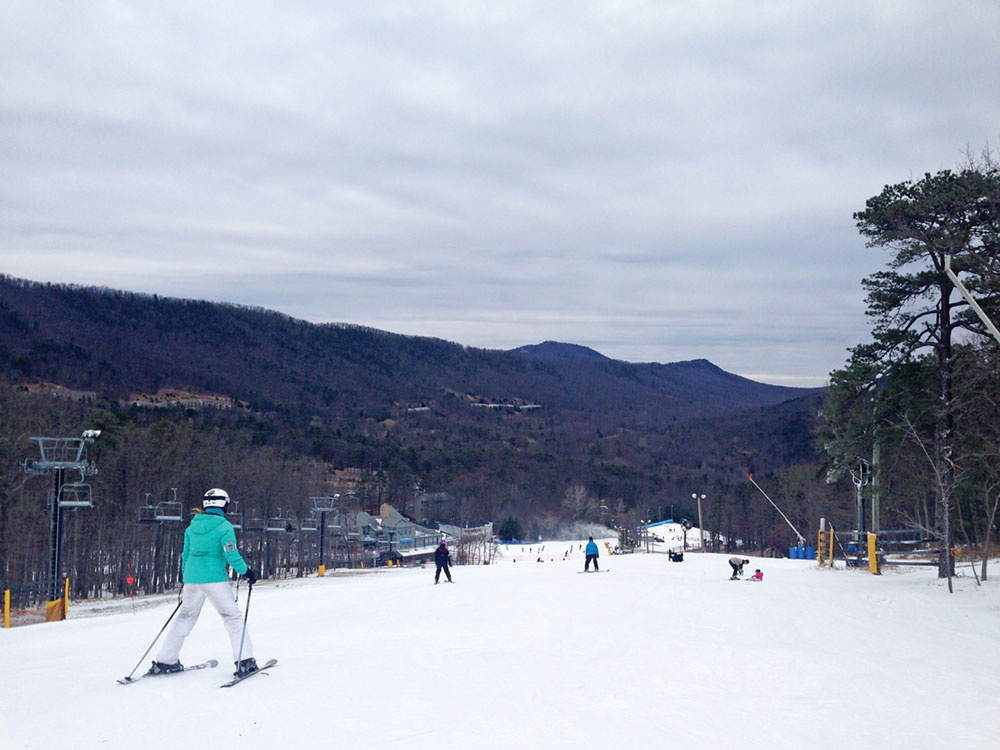
Questions about related ambiguities have inspired my family’s (mild) anxiety. While I’ve read, explained, and prepared for Snowshoe’s myriad COVID policies, experiencing them is another matter. Like, will restricting lift rides to groups of friends and family yield untenable wait times? If so, should we bring lightweight masks to switch into before entering said lines? Then there’s the room’s raging elephant: Will fellow skiers comply with wearing masks and observing social distancing? If they don’t, what will staffers do about it? The list goes on.
Truthfully, these worries are mostly back-of-mind: I don’t believe I’m putting my family at risk or risking bringing the virus home to others. After months of virtual schooling, limited activities, and redundant neighborhood hikes, we’re itching for something more adventurous. And medical experts seem to agree snow sports are a great outlet.
“Skiing in itself is such a low-risk activity, and it’s a low transmission activity,” says Darcy Selenke, medical director of public health in Grand County, Colorado. “People naturally socially distance when they ski. It’s pretty hard to ski consistently within six feet of anybody.” Avoiding indoor areas and attending close-to-home resorts with strict safety standards renders the activity about as risky as visiting a grocery store.
Still, as veteran season pass holders, we can’t help but wonder how things will play out on-the-ground.
The first visible sign of difference arrives about 20 miles from the resort as we pass through the town of Green Bank, where roadside billboards read, in all caps, “MASK UP!” The second comes in the Top of the World parking lot, which services two rental shops, an eponymous hotel, and the Soaring Eagle lift.
It’s around 11 a.m. on a Friday with excellent conditions and not only are back rows mostly empty, numerous spots are available near the slopes. Families and groups of friends huddle around tailgates with pop-up tables, lawn chairs, and coolers, getting dressed and eating snacks.
“We’re encouraging [day visitors], whenever possible, to [put on snow gear] in their cars,” says Snowshoe digital marketing manager and spokesperson, Shawn Cassell. The same goes for eating. While some on-mountain restaurants are open, they’re operating at about 50 percent capacity, with outdoor patio space restricted as well. Takeout or packed lunches are thus strongly encouraged. Overnight guests are being asked to treat their room like a mini-lodge for off-slope entertainment, dressing, and eating meals.
“The goal is to minimize indoor traffic and preclude congestion,” says Selenke, who consulted with Winter Park Resort about pandemic safety protocols last fall. She points to a case-study of a March 2020 super-spreader event at an Austrian ski area, where some 6,000 new virus cases in 50 countries were linked to slope-side parties. Social gatherings, not skiing, were responsible for spreading the virus.
Hess, the Massanutten snow sports manager, says applying the above strategy to rental facilities has been one of his biggest challenges. Most resorts, including Massanutten, have sought to curb crowding through digital reservations, additional rental sites, and modified fitting and pickup procedures.
“This is an area where we’ve really had to get inventive,” says Hess. Like many smaller resorts, Massanutten has just one on-mountain rental shop; pre-COVID, heavy weekend foot traffic was normal. But with lift tickets now being sold exclusively online, Hess’s team has added digital rental services to better anticipate demand and arrival times. New outdoor check-in areas equipped with automated fitting machines help maintain social distancing and reduce indoor exchanges dramatically.
At Snowshoe, my kids and I observe new distancing systems while taking a pre-slope bathroom break. Signs near entryways assert mandatory masks and outline one-way traffic patterns through hallways; arrows and lines taped on floors act as guidelines. Rental shop employees stand behind plexiglass barriers while customers wait in taped-off areas spaced eight to ten feet apart. Hand sanitizing stations are situated at every doorway and intersection. The number of tables in a sports bar type eatery look to have been reduced by about 80 percent. But for spotting a couple and a family in ski gear—both cordially averting masked faces from us as we pass—I’d be inclined think it was the offseason.
Hitting the slopes brings a pleasant surprise. The usual herd of skiers and snowboarders clogging the intersection of lift exit and rental shop entry is thin and widely dispersed. Instead of say, 50 to 75 people mulling about, there are 20 to 30 tops. This is the result of state-imposed capacity limits.
After opening on December 19, “lift tickets more or less sold out through most of the holiday season,” says Hess. But that statement comes with a caveat: To ensure safety, Massanutten has voluntarily limited slope access to around 1,200 people at any given time, including season pass holders. In 2019, that number averaged around 2,500.
Accordingly, we find the skiing to be fantastic. While green trails aren’t exactly lonely, largely untrammeled snow along off-piste edges implies significantly fewer riders. We carve up banks, slaloming through trees and hitting drops that excess traffic typically render impassable or too dangerous to attempt. The effect is amplified along blue trails and black diamonds. Here, it feels like a non-holiday Tuesday—there’s tons of room for high-speed carving and no worries of getting t-boned by errant beginners.
Approaching the lifts, however, brings a jolt. The lines look huge. Meanwhile, I’m forced to follow my kids, who’ve made the mistake of zooming right in. After so much exertion, we’re breathing heavy, which creates moisture inside our balaclavas. Though the wait isn’t actually all that long—six feet of distancing, fewer lanes, and no singles line has created the illusion of queuing up for a Disney World thriller on a Saturday—wet masks are itchy, hot, gross, almost unbearable. I maneuver into a lightweight cloth replacement (which isn’t easy); the kids complain, but stick it out. We make a future rule of pulling down masks for at least 100 yards of air-drying followed by a pause to catch our breath before entering lines.
Surveying the scene, it’s definitely weird. Ropes are taped to indicate safe distances in lanes. Masked lift attendants monitor the area, barking, at intervals, “Masks over the nose or we have to close!” Chatter is drastically reduced among groups and more or less nonexistent between strangers. Everyone seems to be gritting their teeth against the discomfort.
But soon enough the chairlift whisks us up and away and masks come down. The crisp cold fresh air and beautiful mountain landscape hits us like a shot of raw joy. My kids agree: The experience justifies the inconvenience.
Back at the top, we v-line for the terrain park. There, lift lines are much shorter and our new pre-queue strategy makes waiting infinitely more bearable. Traffic at the park’s entry proves heavy, but groups behave respectfully, maintaining distance and dispersing across the slope to wait before dropping in. And while that does create some added confusion, in terms of the virus, it leaves me confident about my family’s safety.
As of the time of writing in January, my kids and I have spent eight days at Snowshoe and one at Massanutten. Overall, I’ve been inspired by how well skiers and snowboarders have adapted to rules that help to ensure safety—and an ongoing ski season.
While we’ve witnessed occasional problems, ski patrollers and lift attendants have been quick to diffuse them.
In one case, a family argued against donning masks in line so they could more easily share a hot chocolate. In another, a pair of college-aged season pass holders responded to requests to mask up by proclaiming the virus was “fake news.” Staffers instructed the former to cover their nose and mouth or forfeit lift tickets. The latter were given facial coverings and told to choose between wearing them or getting banned for the season.
“We’re taking safety extremely seriously,” says Cassell, adding that cameras have been installed at various lifts and are being monitored by state lawmakers to ensure compliance. Too many infractions could force the resort to shut down. “But that’s not really the point,” Cassell continues. “This is people’s health we’re talking about here. The stakes are too high to [tolerate negligence].”
Luckily, says Hess, the vast majority of visitors are following the rules.
“For this to work, it’s got to be a partnership,” says Hess. Trying to run a ski resort during a pandemic is exhausting. He looks forward to when the weather is once again his biggest worry. In the meantime, “if we work together, I feel confident we can keep everyone safe and do our part to ensure the slopes stay open through the winter.”
Cover photo courtesy of Getty Images
